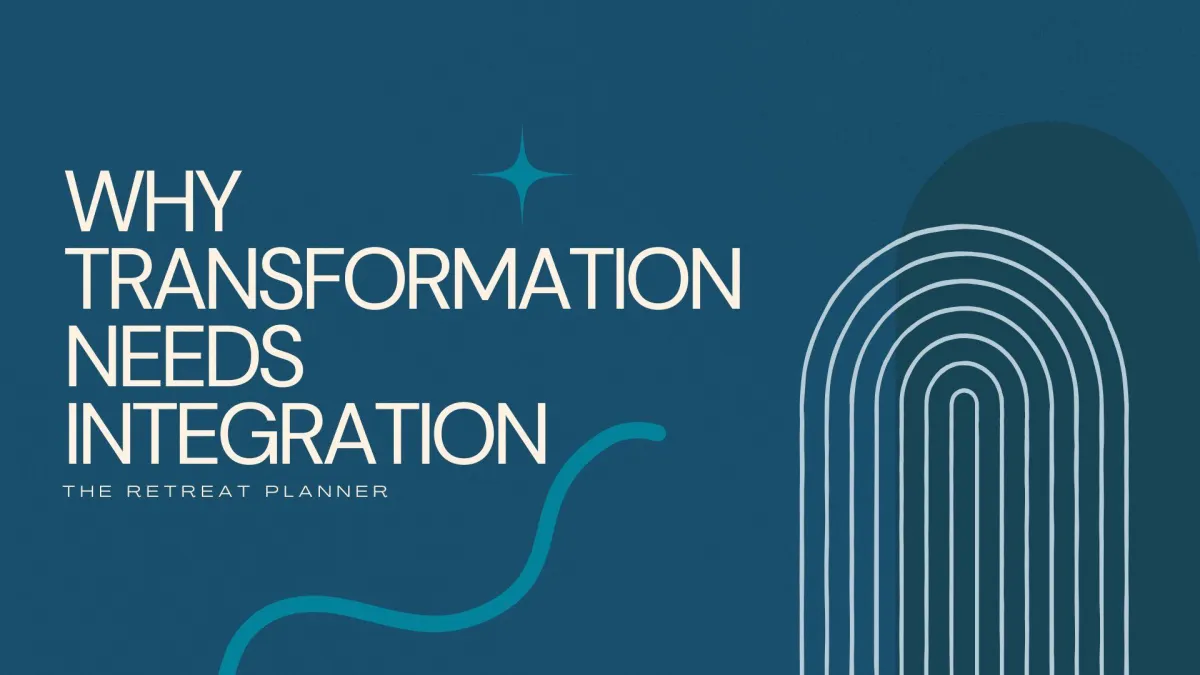How To Run Profitable Retreats Blog

Why Transformation Needs Integration
“Why Transformation Needs Integration"
In the fast-paced world of retreats and personal development, the concept of transformation is often celebrated. Shifting perspectives, uncovering breakthroughs, and inspiring growth are cornerstones of these experiences. Yet, as powerful as transformation can be, it’s only

half the equation. Without integration, transformation can feel fleeting—a spark that ignites but fails to sustain.
True, lasting change occurs when transformation is followed by intentional integration. In this article, we’ll explore why integration is essential and how retreat leaders can design experiences that ensure participants leave not just inspired but truly transformed.
The Challenge of Transformation Without Integration
Imagine attending a life-changing retreat where every moment feels profound. You journal deeply, cry tears of release, and connect with others in ways you’ve never experienced before. But then, the retreat ends, and life calls you back to its daily demands. Without time or tools to process what you’ve experienced, those breakthroughs start to fade.
This is the reality many retreat participants face. Transformation is exhilarating, but it can also be overwhelming. If participants aren’t given space and guidance to integrate their experiences, the lessons they’ve learned often fail to take root. They may struggle to apply their insights in practical ways, leading to frustration or a sense that the retreat didn’t “stick.”
Why Integration Matters
Transformation without integration is like planting seeds without nurturing the soil. The experience might feel impactful in the moment, but it lacks the sustainability to create meaningful change. Integration bridges the gap between inspiration and action, helping participants:
Process their experiences: Reflection and stillness allow insights to settle and deepen.
Apply lessons to life: Integration provides practical tools for turning ideas into habits.
Navigate emotional shifts: Retreats often bring up powerful emotions that need time to be understood and embraced.
Build confidence in their growth: By integrating, participants see real progress and feel empowered to continue their journey.
How Retreat Leaders Can Support Integration
Creating space for integration isn’t just an added bonus; it’s a responsibility for retreat leaders who want to deliver transformational value. Here are some ways to weave integration into your retreat planning:
1. Design Schedules with Downtime
Busy schedules can be exciting, but they leave little room for reflection. Include intentional breaks where participants can journal, meditate, or simply rest. These moments of stillness help them absorb their experiences and prepare for the next step in their journey.
2. Facilitate Closing Workshops
Dedicate time at the end of your retreat for an integration-focused workshop. Use guided exercises to help participants map out how they’ll incorporate what they’ve learned into their daily lives. Encourage them to set small, actionable goals that feel achievable.
3. Provide Post-Retreat Support
Integration doesn’t stop when the retreat ends. Offer follow-up resources, such as workbooks, videos, or group calls, to keep participants engaged with their growth. Creating a supportive community space, like a private online group, can also help them stay connected and accountable.
4. Emphasize Reflection Throughout
Build reflective practices into every phase of your retreat. Whether it’s a group sharing circle, a guided visualization, or an individual journaling session, these practices create continuous opportunities for participants to process and ground their experiences.
The Impact of Integration on Your Retreat’s Success
Prioritizing integration doesn’t just benefit your participants; it elevates your retreat business. When attendees leave your retreat feeling truly changed and equipped to sustain that change, they become your greatest advocates. They’ll share their success stories, recommend your retreats, and return for future offerings because they trust your ability to

deliver lasting value.
In an era where trust and authenticity are paramount, the retreat leaders who prioritize integration will stand out. You’ll be seen not just as someone who facilitates powerful experiences but as someone who truly invests in the long-term growth of your clients.
Transformation + Integration = True Change
Transformation is the spark, but integration is the flame that keeps it burning. By designing retreats that honor both, you create experiences that don’t just inspire but also empower.
As you plan your next retreat, ask yourself: How can I ensure my participants leave not only transformed but also ready to integrate those transformations into their lives? The answer to this question holds the key to creating retreats that change lives—not just for a moment, but for a lifetime.
BOOK A CALL TO FIND OUT YOUR RETREAT BLUEPRINT & BECOME A RETREAT BUSINESS OWNER
With love,
Leni


